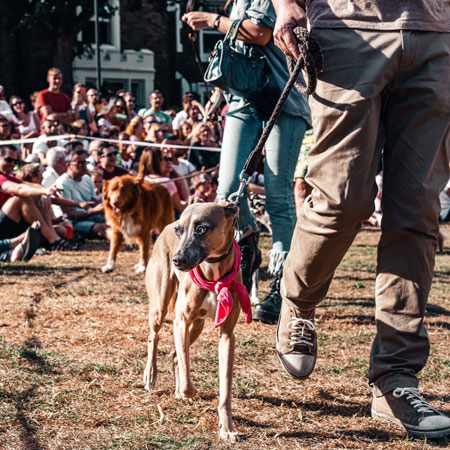There are many negative stigmas and myths surrounding attending dog shows, either as a guest or competitor. We want to dispel these rumours and teach you step-by-step how to get started in dog showing.
At first glance, you may think it’s a daunting task with too much to learn to even think about attending. In reality, it just takes a few months of practice and dedication. One of the main attractions of dog showing is the community behind it, there will always be plenty of people more than happy to help you along with your journey.

Showing your dog not only provides you with great quality time with your pet, but it also provides a great education into the specific dog breeds as well as invaluable insight into the care of your dog. Picking up a variety of skills and home care remedies that can save you serious money on vet bills.
One of my favourite things about dog shows is the warm and friendly participants, many of whom grew to be my close personal friends over time. In most cases, you will find an instant connection and something in common with the participants because of the similar characteristics which drew you to your particular breed of dog!
For those who own a mixed breed of dog, there are still shows to attend. The mixed breed events are mainly organized during the summer months and offer a more light-hearted and less competitive tone for a great family day out with your pet.
So, let’s get started on the first step of getting your dog show-ready.
Breed of dog
The majority of people will never choose their dog with the intention of picking the best dog for attending dog shows. You will likely have been drawn to your breed of dog because of knowledge previous, leading you to pick a breed which fits in with your lifestyle.

It may have been a case of when having purchased your puppy, the breeder suggested the possibility of dog showing because of the quality of your dog. A lot of the time, the breeder will actually offer to mentor you in dog showing. This is because, at the end of the day, it will be their kennel name on the KC (Kennel Club) certificate. This means they have a vested interest in the success of your puppy as they also reap the rewards.
A good mentor will guide you through this process step by step and explain all the aspects of showing from start to finish and anything in-between. That’s exactly what we’re going to do with these series of blog posts!
Baby steps to getting started with dog showing
Let’s say that you have decided to show your pedigree dog. The first three to six months with your puppy should be focused solely on bonding with your puppy and making the house rules clear to them. We don’t want to run before we can walk.
From the early age of around 6 months and older, then we can begin the real dog show training.

As many of you may have watched Crufts on the TV and some may have attended as spectators, it looks easy to see people walking around the show ring proudly showing off their dogs. While it may not be rocket science, there is an art to the craft which both you and your pet will need to learn.
While training, both you and your dog will work together and develop an incredible bond which will be visible when in the show ring. You will be working together to proudly demonstrate to the judge that your dog is the best out of the bunch.
So how do you achieve this?
Pet Training Equipment for a Dog Show
One of the very first thing you need to identify, is if your dog is motivated by a toy or by food. These are the bargaining chips which encourage your dog to perform.
You will also have to invest in a show lead. There are many online breed clubs which are able to recommend the very best choice for your particular breed of dog. Through these clubs, you can also learn the correct way on how your particular breed of dog should wear their lead.
This may sound obvious, but some breeds will have the show lead loose while other breeds require the lead tighter in order to hold your dogs head higher when in the show ring.
Dog Show Training
Now that you have your equipment and the base knowledge of how to use it, you will need to find yourself and your dog a quiet place to train where there is little chance of them being distracted.
The first thing we’re going to teach the dog is how to stack. This means standing and holding the correct posture position.
Teaching your dog to stack
The correct stack position for your breed may differ from others, you should always research images and videos of your particular breed in competition. Study this material carefully as you need to train your dog the correct way from the very beginning.
Below are two images which demonstrate the difference between a standing posture and a stacked posture.
As you can see, the stacked posture demonstrates all of the dogs prowess. You can see the dogs great health and pristine condition.
One of the very first things you must adopt as an owner and trainer is patience. Your dog will be more than capable of holding this position for a long period of time, but may choose not to as they have other plans or ideas. This is where we can introduce their favourite food or toy.
It’s a relatively simple concept to train your dog to stack this way, but as mentioned above, requires patience. Everytime your dog adopts the correct posture, you simply reward them with their treat. The trick is not to expect your dog to be standing stacked up for a long period of time before rewarding them. Your pet should only be holding the position for a second before being offered the reward.
As soon as the dog adopts the correct posture, give them a gentle one word command of stack or stand before rewarding them. You may have to tease the dog gently into position at first in order to get them into the correct posture.
Always remember that patience is your best friend at this stage and you will require plenty of it. You should slowly build up the time that they are able to hold this stacked position. I must stress that there is no time limit on this process, some dogs and breeds can take longer to teach than others.
The main skill is staying both patient and consistent. While training, the dog should also be using a show lead. Your pet can then associate wearing the lead as the time to perform at their best.
I promise that your pet will love training with you and there’s no better way to create a strong bond.
How to Gait your Dog
Another step of our training is how to gait your dog. This means training your dog how to correctly move around a show ring. Again, as with other parts of training, this differs from breed to breed. Some dogs will prefer to walk around the show ring and others will run.
Now this is something that your dog will actually already know, the training aspect is to gauge your dog’s best pace. Be it running or walking, this is where you as the owner must adjust to the speed of your dog. You cannot expect your dog to adjust to your speed, you will want to dog to look as natural as possible when moving around the ring.

While one of the easier aspects of training, it is still an important step as it will also prevent your dog from becoming distracted when in the show ring.
Once you have comfortably gauged your dogs pace, you will then need to hold their attention. The easiest way to do this when getting started is to hold their toy or tasty treat to your chest. When holding it to your chest, you can let the dog know it’s there but only reward them when they move with you correctly. If you dog becomes distracted while moving, simply stop and calm the dog down before starting your movement again.
You should only reward your dog when they have moved with you correctly. You will not get this right the first time and you should not expect to do so, this element of training is for both you and your dog to flow together.
Another important element of this is that the dog lead must always be held in the left hand and you will always be moving in a clockwise direction when in the show ring.
In Part 2 of this blog series, we will take a look at the next stage of training for you and your dog – Ring Craft.
Click here to find out why our PetWorld Cages are better than our competitors



